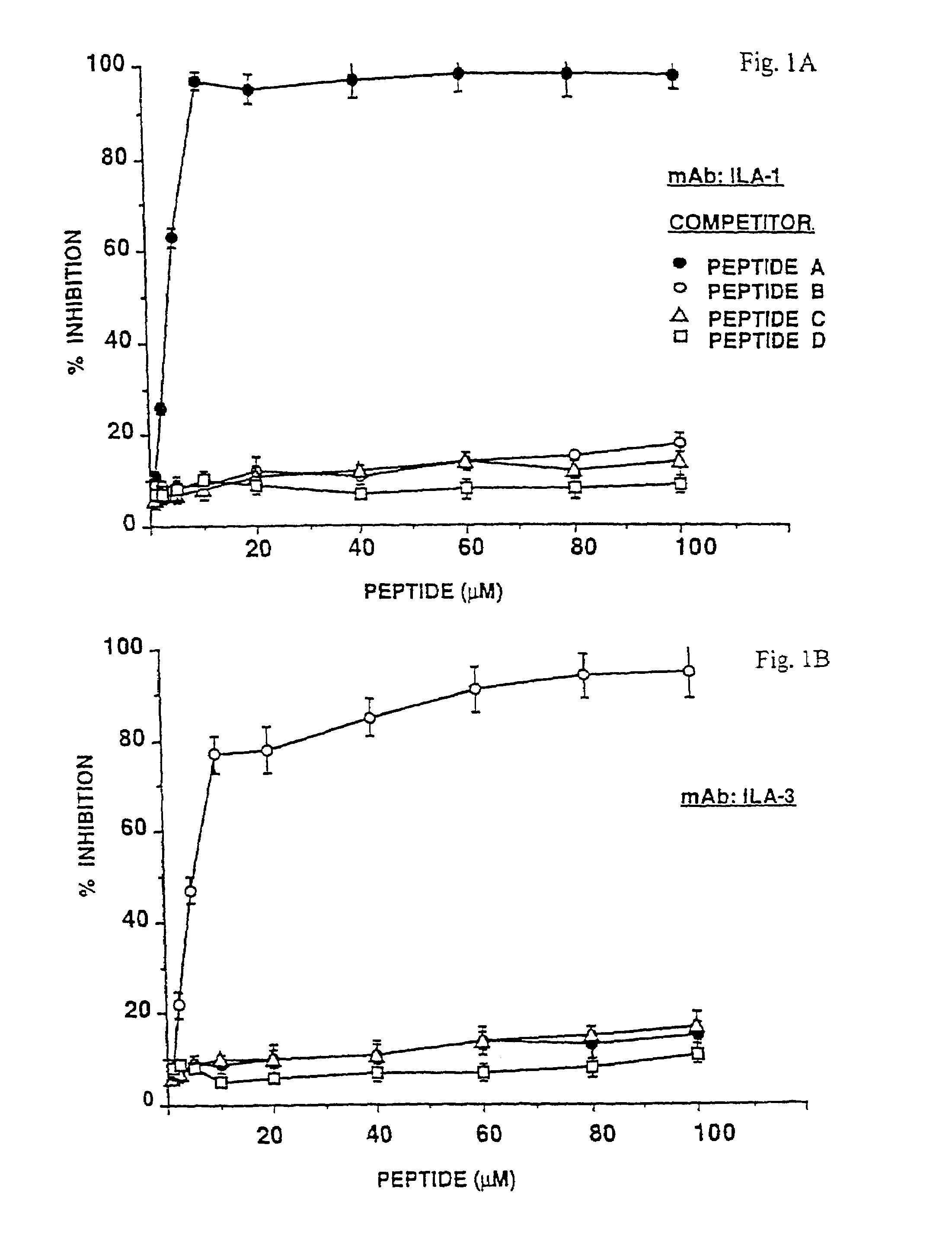Synthetic peptides and kits for diagnosis of anti-phospholipid syndrome
a technology of synthetic peptides and kits, applied in the field of synthetic peptides, can solve the problems of fetal death of women with anti-phospholipid antibodies, and achieve the effect of specific treatment and quick diagnosis of the presen
- Summary
- Abstract
- Description
- Claims
- Application Information
AI Technical Summary
Benefits of technology
Problems solved by technology
Method used
Image
Examples
example 1
Isolation of Peptide-Presenting Phases Binding Specifically to Anti-β2GPI mAbs
[0105]The anti-β2GPI mAbs ILA-1, ILA-3 and G-3 were subjected to a phage library containing random hexapeptides to determine peptide sequences which are recognized by them, as described in Materials and Methods, section (c). Three rounds of selection were performed, and selected phages were randomly chosen for sequencing after the third round. The different sequences in phages, probed by the biotinylated mAbs, are summarized in Table 1.
[0106]
TABLE 1Binding of anti-β2GPI mAbs to phage isolated from an hexapeptideepitope libraryEpitopeBindingPhagesAntibodysequence*SEQ ID NO:O.D.identified, no.ILA-1L K T P R V8 (res. 3–8)975 ± 7224K T P R V T121201 ± 14218ILA-3K D K A T F131178 ± 10115G-3T L R V Y K14791 ± 3312T K L R V Y15954 ± 627T L L R V Y16869 ± 7116Binding of anti-β2GPI mAbs 5 μg / ml, to 109 phage particles / well, by ELISA (O.D. at 405 nm). Binding of ILA-1 to irrelevant hexapeptide PVRSPH resulted in O.D...
example 2
Inhibition of Binding of Anti-β2GPI mAbs to β2GPI and to Endothelial Cells by the Synthetic Monomer Peptides A, B and C
[0109](2a) The specificity of interaction of the mAbs with the corresponding synthetic peptides A, B, C and control peptide D as monomers, was assessed by inhibition experiments as described in Materials and Methods, sections (e) and (f).
[0110]The results depicted in FIG. 1A show that peptide A (filled circles) inhibited ILA-1 mAb binding to β2GPI by 97% at 10 μM peptide concentration, while peptides B and C, directed to other locations on the β2GPI molecule, as well as irrelevant peptide D (open circles, open triangles and open squares, respectively) did not have any inhibitory effect (10%, 11% and 8%, respectively), at the same peptide concentration. Peptide B abrogated the binding of ILA-3 mAb to β2GPI by 77% (FIG. 1B, open circles), and 98% inhibition of G-3 mAb binding to β2GPI was exhibited by peptide C (FIG. 1C, open triangles), both at 10 μM peptide concentr...
example 3
Peptides which Bind Specifically to anti-β2GPI mAbs have a Preventive Effect on the Ability of the anti-β2GPI mAbs to Enhance Monocyte Adhesion to Endothelial Cells
[0112]The adhesion of monocytes to endothelial cells (EC) is considered a marker of EC activation. The percentage of adhesion is expressed as the portion of added U937 monocyte cells adhering to the HUVEC (thus reflecting the percentage of HUVEC coverage by the monocytes). The ability of the peptide monomers A, B and C to prevent activation of HUVEC via decrease of the adhesion percentage of U937 monocytes to HUVEC, was tested as described in Materials and Methods, section (g).
[0113]As shown in FIG. 3A, ILA-1 mAb preincubated with peptide A (filled circles) inhibited the adhesion of U937 to HUVEC under the experimental conditions used by 84% at 10 μM peptide concentration, as compared to 6–17% inhibition in the presence of peptides B and C, or of irrelevant peptide D (open circles, open triangles and open squares, respect...
PUM
| Property | Measurement | Unit |
|---|---|---|
| total volume | aaaaa | aaaaa |
| temperature | aaaaa | aaaaa |
| pH | aaaaa | aaaaa |
Abstract
Description
Claims
Application Information
 Login to View More
Login to View More - R&D
- Intellectual Property
- Life Sciences
- Materials
- Tech Scout
- Unparalleled Data Quality
- Higher Quality Content
- 60% Fewer Hallucinations
Browse by: Latest US Patents, China's latest patents, Technical Efficacy Thesaurus, Application Domain, Technology Topic, Popular Technical Reports.
© 2025 PatSnap. All rights reserved.Legal|Privacy policy|Modern Slavery Act Transparency Statement|Sitemap|About US| Contact US: help@patsnap.com



